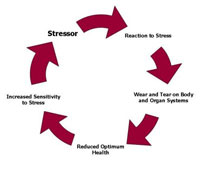 As anyone who has worked in customer service can tell you, a customer service job can be highly stressful. If this stress gets out of hand it can have many negative effects.
As anyone who has worked in customer service can tell you, a customer service job can be highly stressful. If this stress gets out of hand it can have many negative effects.
The Health and Safety Executive (HSE) defines stress as an ‘adverse reaction people have to excessive pressures or other types of demand placed on them’.
Prolonged workplace stress leads to absenteeism, sickness, dissatisfaction, high employee turn-over, and reduced job efficiency.
Work-related stress is also thought to be linked to a variety of physical and mental disorders, either by directly contributing to ill-health, or by increasing the tendency for those affected by stress to engage in behaviors that lead to illness and disease.
Customer service stress
 Customer service personnel are vulnerable to stress as they are typically expected to handle pretty much any possible complaint or problem a customer might have.
Customer service personnel are vulnerable to stress as they are typically expected to handle pretty much any possible complaint or problem a customer might have.
The stress and anxiety of having to find solutions to problems that, in most cases, are not the customer service representatives’ fault. They also have to deal with unreasonable or even angry customers.
This type of stress may be manageable for a day or two, but if your company is consistently on the receiving end of customer complaints, the situation can be overwhelmingly stressful.
Long hours, threats of being laid-off, and workplace bullying can also cause harmful emotional and physical responses. Even petty office politics can be the cause of stress, making employees irritable and rash with their decisions.
Symptoms of stress: what to look out for
- Headache
- Upset stomach
- Aching muscles
- Restless sleep
- Fatigue
- Loss of appetite
- Irritability
- Low morale
How to break the cycle of stress
 The Health & Safety Executive (HSE) has identified six personal strategies to break the stress cycle:
The Health & Safety Executive (HSE) has identified six personal strategies to break the stress cycle:
- Demands – such as workload and work environment
- Control – a person’s individual influence over how their job is carried out
- Support – from the organization; management and colleagues
- Relationships – to reduce conflict and deal with unacceptable behaviour
- Role – understanding of what the job entails; what is expected and needed
- Change – how change is managed within the organization
It’s worth looking at each of the above areas and taking action where necessary. Are there any issues that you can tackle right away?
Ideas for Combating workplace stress
- Perspective – view problems at work as a challenge and nothing more
- Balance – find time to focus on your personal and family life
- Social Network – surround yourself with colleagues and friends you can lean on
- Positive Outlook – let work-related issues cease to bother you at work
- Proper Planning – schedule your business trips and other matters, but leave room for adjustments
- Yoga – preferably in a gym near your office
In order to tackle stress in the workplace, organizations need to have stress management programs. Managers should be concerned with employees’ mental and physical health, help solve difficult work situations and get to the bottom of the causes of stress.
Learn how to recognize customer service stress—and do all your can to alleviate it.
About the Author
Ian Miller is Editor of Customer Service Manager Magazine – the leading resource and community for customer service professionals.




